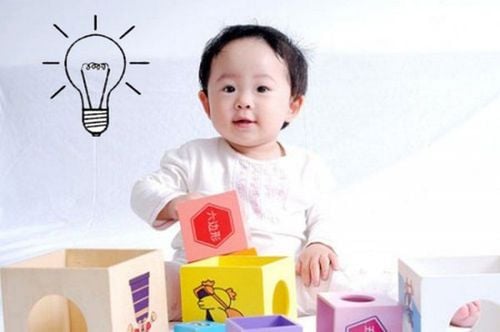This is an automatically translated article.
The article is written by Master Music Therapy Technician - Unit of Regenerative Medicine Clinic and Educational Psychology - Vinmec Times City International General Hospital
Movement to music is one of the musical activities that bring many meanings and benefits to children with autism. Not only helps children form imitation skills, gross motor but also effective in the goals of developing social interaction skills. While some children love music, are always excited and happy when listening and dancing to the rhythm of music, some children need music as motivation to perform motor exercises. body.
As we all know, the attention and concentration ability of children with autism is not high, so maintaining activities is also one of the goals children need. In addition to hands-on exercises with music, some props and objects to attract children's attention are also used by families in movement activities with music.
1. Chiffon
This is a very familiar item, cheap price, easy to find and buy at bookstores, toy stores or markets. This towel is colorful, light, thin and handy.
Guide some musical activities with chiffon:
1.1 Toss and catch the towel to the rhythm You should choose soft music, have a moderate speed and guide the child to throw and catch the towel to the rhythm of the song. music. Chiffon scarves, when bounced up and down, often attract and stimulate the eyes to attract and develop the attention span of autistic children when they follow the movement of the chiffon.
Besides, the exercise helps promote many senses at the same time, children's ears need to listen to music, children's eyes need to follow towels, children need to feel themselves to move and catch the veil. With this activity, you can guide your child to toss and catch the towel on his own to the rhythm. Children can also be guided to throw and catch towels with others to develop playing skills, children know how to wait their turn, and play alternately.
1.2 Mimic movement with chiffon You should use instrumental music with repeated melodies, the duration of a piece of music is about 2-4 minutes depending on the concentration level of each child. Instruct children to imitate movements with chiffon such as: Move left/right, raise/lower towel, rotate circle, wavy... according to the rhythm of the music.
2. Elastic band
Elastic band is made of rubber material designed by colorful seams with cotton felt outside. This type of rope is often used in group lessons, activities designed for children to interact in circles and develop social interaction skills with peers. Depending on the number of participants, you can choose the short length of the elastic band to suit.
Guide some musical activities with elastic bands:
2.1 Small group activities (about 2-4 people) This activity is quite suitable for use in the family model, all members participate in the activity with children. Along with music, activity with elastic helps children with autism connect emotionally and interact with the rest of the family. Because this is a play activity, do not force or try to create situations to force children to interact.
The whole family can sit in a circle, put the elastic band in the middle, members will hold 2 hands on the rope, swing the rope and sing songs that children love or choose songs for children. Nhi is about 4 lines long. Children with autism will be placed in the center of a circle, moving around when the music is heard, or stopping in front of a loved one when the song ends. Teach a greeting when your child stops in front of you (Example: Bow when stopping in front of grandparents, shake hands when stopping in front of children, hug when stopping in front of parents or high five when standing in front of siblings... )
Parents can also guide the children's siblings how to take turns, take turns entering the circle so that the child learns skills such as: Waiting for turn, simple pretend play when acting as characters. objects to respond to greetings accordingly.
2.2 Large group activity (more than 4 people) This activity is quite suitable for classmates, creating an environment for children to develop playing skills with their peers. Arrange the children to sit in a circle, so that they can observe and have the opportunity to socialize through eye contact, gestures, and facial expressions with all members of the group.
Music often selected in this activity is music without lyrics, with nuances, rhythms, and nature of contrasting passages to represent sounds: Fast/Slow, Loud/Small, Long/Short, High/Low... and the child will listen and move the elastic string according to the nature of the piece of music. Example: Loud (pulls the string to expand), small (puts your hand forward to shrink the rope), fast (fast string movement), slow (slow string movement), high sound (put the string up). high), low sound (putting the string low)... With the contrast in music combined with the change in expression in action, the elastic string is made of rubber, so children can easily feel it. get strong/light, fast/slow... and learn how to express emotions when participating in games in the circle.
3. Silk ribbon
Silk ribbons are made of thin, light, soft fabric, designed in a variety of colors, easy to find at children's toy stores or make your own using connecting ribbons. together.
The music used in the exercise with the silk band is often selected with a gentle, soft musical nature, moderate speed.
Guide some musical activities with ribbons:
3.1 Listen and move to the music This activity allows children to be free to create and express themselves through listening and moving in accordance with the sound. music.
Turn on a melodious song and model beautiful movements with silk ribbons (waves, zigzags...) to attract children's attention. When children begin to pay attention and accept interactions with adults, give them a strip of silk, hold hands and guide them in a few basic movements to move with silk such as (lifting up / down, bringing them up). forward/backward, circle). Encourage your baby's creative movements, imitate your baby's movements to develop social interaction, and start engaging in twin movements with the ribbon.
3.2 Mirror movement A movement with a pair in which one person observes and imitates the movement of the other. Let the child be the initiator first and the adult to imitate the child's movements correctly and vice versa, the child to imitate the adult's activities.
Depending on the child's ability to imitate, choose a song with a long or short repeated sentence length. For children with good imitation ability, choose sequence movements (from 2 movements or more) to develop children's observation and memory ability.
4. Umbrella color
Many children with autism have sensory problems. While some children have problems with sight, touch, taste, and hearing, others have difficulty perceiving the somatic, vestibular system. Using umbrellas with 7 colors of the rainbow, thin, light and sturdy fabric can design a variety of play activities to support children with sensory difficulties. Note, each child has their own sensory difficulties, so the use of music as well as the design of activities is separate, depending on the goals of each group of children.
Guide some musical activities with colored umbrellas:
4.1 Visual stimulation Choose music with moderate speed, gentle melody, put the child on his back on the floor, adults raise the umbrella up/down or move in a circle around the child to the beat of the music. Note tossing/lowering the umbrella in the right rhythm so that the child can feel and judge the direction of the umbrella's movement.
4.2 Stimulating hearing Select music with clear and contrasting musical properties such as high/low pitch, play/stop, fast/slow... then guide the group of children to stand in a circle around the parachute, grasp the edge of the parachute with both hands and move the parachute up/down when you hear a high/low sound, move fast/slow when you hear a fast/slow tempo or shake the parachute to the beat when you hear music and stop when there is no music...
5. Plastic ring
Plastic rings are also one of the familiar and easy-to-find items for preschool children. Plastic rings are often used in gross motor development exercises or group activities.
Guide some musical activities with plastic rings:
5.1 Music game “Going home” This game can be used in group activities, with the goal of getting children to listen to and follow the music. That is, using music as a language, children listen to music to follow the rules that have been guided before.
Rules of the game:
Each child will be given a plastic ring and convention that the plastic ring is the house. Place the hoop on the floor and guide the child to stand inside his or her house. Choose a short and prescribed children's music: When the music is played, the child is allowed to move out of the house, at the end of the music, the child must stand in his house. This game not only strengthens the skill of playing by the rules, but also helps children focus attention and predict things in advance (listen to the tune to prepare to return to the ring before the music ends). We can also help children with problem-solving skills by taking away a house (a bracelet) and observing and guiding the children in the group to share when a house is missing.
5.2 Music game “Mini Train” This is an activity to help children develop skills of pretend play, simple imagination. The game is suitable for organizing during group activities to promote social interaction skills.
Rules of the game:
Line up the children in a row to simulate a train, clinging to each other's shoulders. Use a plastic ring and pretend to be a train's steering wheel. You standing first will be the train driver and hold the steering wheel. Use the Piano/Organ to play the tune of “Little Train” When the song's melody plays, the whole class moves. When it hears the sound of "Pip...Pip" (the sound of the organ on the organ), the train will stop. When you hear a sound from low to high (Play Do, Re, Mi, Pha, Sol, La, Si Do) then you standing at the end of the line will run to the front of the line, take the steering wheel from you first and become the ship driver. When you hear the sound from high to low (Play Do, Si, La, Sol, Pha, Mi, Re, Do), you are the train driver and will give the steering wheel for you to stand behind you and run to the end of the line. Music is a psychotherapy that not only overcomes the difficulties of autistic children such as: language, concentration, social interaction... but also an effective method in helping children and people Take care of children to relieve stress and regulate emotions.
With many years of experience in examining and treating diseases in children, now the Pediatrics Department at Vinmec International General Hospital has become one of the major health care centers, capable of examining , screening and treatment of many specialized diseases in children. Therefore, if the child shows signs of poor absorption of nutrients, slow weight gain, growth retardation, etc., parents can take the child to Vinmec International General Hospital for examination and support. advice from qualified doctors.
Please dial HOTLINE for more information or register for an appointment HERE. Download MyVinmec app to make appointments faster and to manage your bookings easily.













